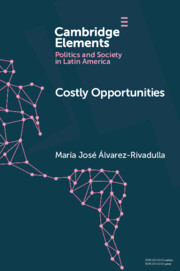126 results

Costly Opportunities
- Social Mobility in Segregated Societies
-
- Published online:
- 01 May 2024
- Print publication:
- 30 May 2024
-
- Element
- Export citation
15 - The South African Landownership Struggle
- from Part III - Sustainable Urban Planning in Africa
-
-
- Book:
- Reimagining Urban Planning in Africa
- Published online:
- 07 December 2023
- Print publication:
- 21 December 2023, pp 261-281
-
- Chapter
- Export citation
5 - Civil Rights and Race in the United States
- from Part II - Political Rhetoric in Practice
-
- Book:
- Political Rhetoric in Theory and Practice
- Published online:
- 02 November 2023
- Print publication:
- 16 November 2023, pp 159-178
-
- Chapter
- Export citation
43 - The Equal Protection Clause and Race
- from Part VIII - Labor, Equal Protection, and Race
-
- Book:
- The Taft Court
- Published online:
- 19 October 2023
- Print publication:
- 09 November 2023, pp 1430-1493
-
- Chapter
- Export citation
2 - The Britishers
-
- Book:
- Multiracial Britishness
- Published online:
- 19 October 2023
- Print publication:
- 02 November 2023, pp 53-89
-
- Chapter
- Export citation
Rodriguez at Fifty: A Legacy of Intersecting Inequalities
-
- Journal:
- History of Education Quarterly / Volume 63 / Issue 4 / November 2023
- Published online by Cambridge University Press:
- 15 November 2023, pp. 444-466
- Print publication:
- November 2023
-
- Article
-
- You have access
- Open access
- HTML
- Export citation
The Roots of Inequality: Texas School Politics and the Leadup to Rodriguez
-
- Journal:
- History of Education Quarterly / Volume 63 / Issue 4 / November 2023
- Published online by Cambridge University Press:
- 15 November 2023, pp. 516-543
- Print publication:
- November 2023
-
- Article
-
- You have access
- Open access
- HTML
- Export citation
12 - African American New History-Writing in Graphic Narratives
- from Part II - Graphic Novels and the Quest for an American Diversity
-
-
- Book:
- The Cambridge Companion to the American Graphic Novel
- Published online:
- 10 January 2024
- Print publication:
- 28 September 2023, pp 210-225
-
- Chapter
- Export citation
Governing Risk Through Forced Confinement: Clawback of Pre-Pandemic Reforms
-
- Journal:
- Canadian Journal of Law & Society / La Revue Canadienne Droit et Société / Volume 38 / Issue 2 / August 2023
- Published online by Cambridge University Press:
- 15 September 2023, pp. 223-244
-
- Article
-
- You have access
- Open access
- HTML
- Export citation
The Spatial Configuration of Segregation, Elite Fears of Disease, and Housing Reform in Washington, D.C.’s Inhabited Alleys
-
- Journal:
- Social Science History / Volume 48 / Issue 2 / Summer 2024
- Published online by Cambridge University Press:
- 31 August 2023, pp. 173-201
- Print publication:
- Summer 2024
-
- Article
-
- You have access
- Open access
- HTML
- Export citation
A Southern White Clergyman, the Freed People, and the Nineteenth-Century Episcopal Church
-
- Journal:
- Journal of Anglican Studies / Volume 22 / Issue 1 / May 2024
- Published online by Cambridge University Press:
- 23 August 2023, pp. 290-309
-
- Article
- Export citation
1 - Gender Equality in College Athletics
-
- Book:
- Equality Unfulfilled
- Published online:
- 06 July 2023
- Print publication:
- 20 July 2023, pp 1-46
-
- Chapter
- Export citation
5 - The Public, Fans, and Policy Support
-
- Book:
- Equality Unfulfilled
- Published online:
- 06 July 2023
- Print publication:
- 20 July 2023, pp 138-163
-
- Chapter
- Export citation
3 - Student-Athlete Contact and Policy Support
-
- Book:
- Equality Unfulfilled
- Published online:
- 06 July 2023
- Print publication:
- 20 July 2023, pp 67-104
-
- Chapter
- Export citation
2 - Wards of the State
-
- Book:
- Multiracial Identities in Colonial French Africa
- Published online:
- 25 May 2023
- Print publication:
- 08 June 2023, pp 63-102
-
- Chapter
- Export citation
14 - Democratic Deliberation in the Absence of Integration
- from Part Two - Philosophical and Normative Foundations
-
-
- Book:
- The Cambridge Handbook of Democratic Education
- Published online:
- 20 April 2023
- Print publication:
- 27 April 2023, pp 230-249
-
- Chapter
- Export citation
Segregated mobility patterns amplify neighborhood disparities in the spread of COVID-19
-
- Journal:
- Network Science / Volume 11 / Issue 3 / September 2023
- Published online by Cambridge University Press:
- 17 April 2023, pp. 411-430
-
- Article
-
- You have access
- Open access
- HTML
- Export citation
Myopic loss aversion: Potential causes of replication failures – ERRATUM
-
- Journal:
- Judgment and Decision Making / Volume 18 / 2023
- Published online by Cambridge University Press:
- 31 March 2023, e7
-
- Article
-
- You have access
- Open access
- HTML
- Export citation
8 - Colonialism’s Uneasy Legacy
-
-
- Book:
- The Cambridge Handbook of Race and Surveillance
- Published online:
- 23 February 2023
- Print publication:
- 02 March 2023, pp 137-165
-
- Chapter
- Export citation
3 - Wideman’s Family Stories and the Carceral Archipelago
- from Part I - The Expanding Canon
-
-
- Book:
- African American Literature in Transition, 1980–1990
- Published online:
- 02 February 2023
- Print publication:
- 09 February 2023, pp 56-76
-
- Chapter
- Export citation



